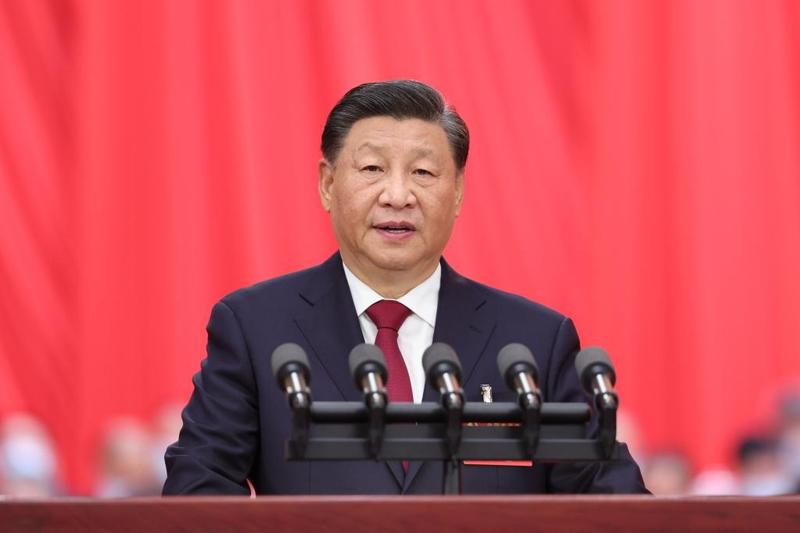Expert says nation's pursuit of common prosperity has great global significance
 Xi Jinping delivers a report to the 20th National Congress of the Communist Party of China (CPC) on behalf of the 19th CPC Central Committee at the Great Hall of the People in Beijing, Oct 16, 2022. (PHOTO / XINHUA)
Xi Jinping delivers a report to the 20th National Congress of the Communist Party of China (CPC) on behalf of the 19th CPC Central Committee at the Great Hall of the People in Beijing, Oct 16, 2022. (PHOTO / XINHUA)
At a crucial moment in which China is embarking on a new journey to build a modern socialist country in all respects, the Communist Party of China has mapped out an ambitious blueprint to comprehensively advance Chinese modernization, a central task it has laid out for the next five years and beyond to realize national rejuvenation.
When delivering a report on behalf of the 19th CPC Central Committee at the opening session of the 20th CPC National Congress on Sunday, Xi Jinping expounded on what the Chinese path to modernization looks like and how it works, and said that it offers humanity a "new choice" for achieving modernization.
Highlighting that Chinese modernization is socialist modernization pursued under the leadership of the Party, Xi said that it contains elements that are common to the modernization processes of all countries, but "it is more characterized by features that are unique to the Chinese context".
Since the founding of the People's Republic of China in 1949, generations of Chinese people have sought to realize the country's modernization.
After China completed the historic task of building a moderately prosperous society in all respects in 2021, Xi ushered in a new stage for the Chinese nation to become modernized on all fronts in the next few decades.
He explained in the report to the 20th CPC National Congress that China's modernization will be shared by a large population, and features the common prosperity of all its people, material abundance and cultural-ethical enrichment, harmony between humanity and nature, and peaceful development.
In a two-step strategic plan, China aims to basically realize socialist modernization by 2035, and then build a great modern socialist country that is prosperous, strong, democratic, culturally advanced, harmonious and beautiful by the middle of this century.
A series of steps have been set out in the report, including significantly increasing economic strength, scientific and technological capabilities, and composite national strength; basically modernizing the system and capacity for governance; improving the system for whole-process people's democracy; and substantially growing the middle-income group.
Alessandro Golombiewski Teixeira, a professor of public policy at Tsinghua University's School of Public Policy and Management, said that common prosperity has become one of the most important concepts guiding Chinese policymakers in recent years.
"This is a bold commitment for all Chinese, and common prosperity will become an important feature of China's socialist modernization," Teixeira said in an article published on the website of China Global Television Network.
"China's practice of pursuing common prosperity is of great global significance. If it succeeds, it will provide the world, especially the vast number of developing countries, with a choice of their own development path."
Alexander Ayertey Odonkor, a Ghanaian author, economic consultant and chartered financial analyst, commended China's ecological conservation efforts while maintaining rapid economic development during the course of its modernization drive.
He said in an opinion piece on the CGTN website that China has sought to balance sustained economic growth, protect the natural environment, and boost harmonious coexistence between humanity and the natural environment — an impressive feat that presents the country as a unique example of how to balance economic growth and protect nature.
Externally, China's modernization faces a more volatile international landscape that is speedily evolving. Factors such as the COVID-19 pandemic, the Ukraine crisis, the increasing geopolitical competition and mounting protectionism and unilateralism have complicated China's development environment.
Peaceful development
Xi said in the report that China has entered a period of development in which strategic opportunities, risks and challenges are concurrent and uncertainties and unforeseen factors are rising. He stressed that in pursuing modernization, China will not tread the old path of war, colonization and plunder taken by some countries.
"Dedicated to peace, development, cooperation and mutual benefit, we will strive to safeguard world peace and development as we pursue our own development, and we will make greater contributions to world peace and development through our own development," he said.
Experts said that the Chinese path to modernization has brought new elements of value to the international order. It provides an alternative to the Western model of modernization, expands the channels for developing countries to achieve modernization, and offers a Chinese approach to human progress, they said.
Yang Guangbin, a professor of political science at Renmin University of China, said that no developed country in the West has developed without relying on war, colonization and plunder.
Instead of plundering through war, China has risen through peaceful development, which is fundamentally different from the way that Western countries have risen and influenced the world, he said.
China's experience offers "China's solution" and China's inspiration to developing countries that want to develop while maintaining their independence, he added.




